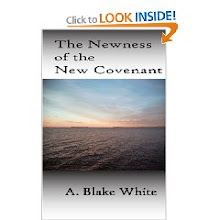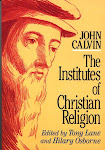 INTRO
INTROWell, we have finally made it to the last major theological system within evangelicalism. We have taken a peak at both dispensationalism and covenant theology. As I have stated in previous posts, NCT is the most consistently Biblical of the three systems. I will spend several posts in an effort to prove this. I have also asked Mike if he would be so kind as to post something on this subject seeing that he has held to NCT longer than I have. Indeed, Mike is the one who originally introduced me to such a thing (as NCT) and encouraged me to read about it. Thus, anything he says on this subject will be a shot in the arm for this blog.
I want to start my analysis of NCT a little different than I did the other systems. Before following my standard outline (definitions, distinctions, dissection), I want to paint with broader brush strokes. In the first couple of posts, I want to focus on the major aspects of NCT. NCT is similar to a beautiful painting that shows the intricate details of trees, a rushing brook, mountains, and animal life. Instead of focusing on the details of the painting, however, let’s look at the obvious things in the painting- the things that stick out. I want to do this because NCT is a little different than the other two systems in my estimation. NCT requires one to cut loose presuppositions (previous thoughts) one typically possesses who has grown up or been part of an evangelical church any number of years. As I made clear in other posts, I had to cut loose my dispensational predilections when I began seeing that there were other ways to understand Scripture. My point is simply that NCT is a more precise system in many ways, I believe, than the other two systems. It answers certain key questions in which the other two systems fail. In order to understand the answers provided by NCT, one has to cut loose his traditional manner of thinking about Israel, the church, and the “law” just to name a few topics. Of course, “cutting loose one’s presuppositions” is always important in studying anything. I would just say that, for me, it was even more imperative when I began studying NCT. Quite frankly, it teaches things most believing Christians are not used to hearing. Nevertheless, we must let the word of Christ indwell us richly as we spoke about Sunday (Colossians 3:16). Scripture is to have the final say in all things. When Scripture rubs against our previously held positions, this is a good thing, not a bad thing. May Scripture control our thinking!
So I want to begin our look at NCT by giving you six basic principles of NCT. These appear in no particular order.
NCT’S PRINIPLE OF INTERPRETATION
Let me make a few general comments. NCT teaches that the New Testament Scriptures must always interpret the Old Testament Scriptures. In other words, if one wants to understand the Old Testament, he must turn to the pages of the New Testament and read. An understanding of what the NT says about the OT renders a proper understanding of the OT. If we allow the OT to interpret the NT, then we run the risk of confusing the identity of both ethnic Israel and the church. This is what DT tends to do. On the other hand, if we only allow the NT to interpret the OT some of the time, then we run into the danger of being inconsistent in our overall interpretation of the Bible. This tends to be the propensity of CT. I strongly believe that when we allow the NT Scriptures to tell us the true meaning of the OT Scriptures, Christ holds a more central place in redemptive history.
NCT’S PRINIPLE OF INTERPRETATION
Let me make a few general comments. NCT teaches that the New Testament Scriptures must always interpret the Old Testament Scriptures. In other words, if one wants to understand the Old Testament, he must turn to the pages of the New Testament and read. An understanding of what the NT says about the OT renders a proper understanding of the OT. If we allow the OT to interpret the NT, then we run the risk of confusing the identity of both ethnic Israel and the church. This is what DT tends to do. On the other hand, if we only allow the NT to interpret the OT some of the time, then we run into the danger of being inconsistent in our overall interpretation of the Bible. This tends to be the propensity of CT. I strongly believe that when we allow the NT Scriptures to tell us the true meaning of the OT Scriptures, Christ holds a more central place in redemptive history.
The Reformers used an interpretive principle when they broke away from the Roman Catholic Church. They called it the Analogy of Faith. It was a principle that compared Scripture with Scripture to show the unity of God’s revelation. In other words, the Reformers would allow more clear passages of Scripture to elucidate and clarify more ambiguous passages. They did this with both the OT and NT. NCT, on the other hand, does the exact same thing except they emphasize the importance of giving logical priority to the NT over the OT. In fact, this was the way the Apostles interpreted God’s plan of redemption (see Acts 2:14, Peter’s sermon). In addition, the author of Hebrews does this throughout his letter. And, of course, the Apostle Paul does it throughout his letters as well.
NCT’S PRINCIPLE OF SEPARATION
Within NCT is a firm affirmation that the Old Covenant (Mosaic Covenant) is completely different in character to that of the New Covenant. There is strong separation between these two covenants. They stand in strong contrast to each other. And this fits in accordance with God’s overall sovereign plan of redemption. It is argued that Scripture always emphasizes the discontinuity between these covenants, not continuity, as CT proponents will argue.
NCT’S PRINCIPLE OF SEPARATION
Within NCT is a firm affirmation that the Old Covenant (Mosaic Covenant) is completely different in character to that of the New Covenant. There is strong separation between these two covenants. They stand in strong contrast to each other. And this fits in accordance with God’s overall sovereign plan of redemption. It is argued that Scripture always emphasizes the discontinuity between these covenants, not continuity, as CT proponents will argue.
The clearest way in which one sees that the New Covenant and Old Covenant are separate, contrasting covenants involves a simple observation regarding the people of each covenant. For instance, the people of the Old Covenant (the people of the Mosaic economy) were largely composed of unbelieving rebels. Interestingly, the nation of Israel broke the covenant before it was even ratified! They were led by one rebellious and idolatrous king to another. They never obeyed the stipulations of the covenant perfectly. There did exist genuine believers among the nation, nevertheless, from top to bottom the nation was composed of rebellious idolaters (I Kings 19:18; Psalm 73:1; Romans 9:6-8). On the other hand, the people of the New Covenant are all regenerate. All citizens of the New Covenant are real believers in Jesus Christ, chosen before the foundation of the world. In addition, all believers in the New Covenant are characterized by obedience and submission to Christ their King (Jeremiah 31:34).
NCT’S PRINCIPLE OF UNIFICATION
NCT’S PRINCIPLE OF UNIFICATION
As I pointed out in my posts on CT, Genesis 3 provides a promise that is progressively revealed until Christ came. This promise by God said that the Seed (Christ) of the woman would crush the head of the serpent (Satan). The first coming of Christ is the fulfillment of this promise. He fulfilled the promise through His obedience. NCT understands that this promise provides only one way of salvation- by grace through faith. In other words, at every point in redemptive history, salvation has always been by grace through faith (Romans 4, Abraham’s faith; cf. Genesis 15). Though there exists discontinuity between the Old and New Covenants, there exists continuity in the only instrument of salvation being faith in the promise of God to redeem sinful man. This was the basis of Paul’s argument in Galatians (Galatians 3:16-18). The Old Covenant, though very different than the New Covenant, does not change God’s promise made to Abraham, which is simply an extension of His promise in Genesis 3.
Lord willing, I will post the final three principles of NCT tomorrow.
Lord willing, I will post the final three principles of NCT tomorrow.
Blessings,
Andy
Andy








No comments:
Post a Comment